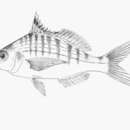pms
nòm ant ël fil


Gerres nigri és una espècie de peix pertanyent a la família dels gerrèids.[5]
Menja peixos, gambes, mol·luscs, plàncton i detritus.[9]
És un peix marí (tot i que entra sovint als estuaris i les llacunes costaneres), de clima tropical i bentopelàgic que viu fins als 60 m de fondària.[6][10]
Es troba a l'Atlàntic oriental: des del Senegal fins a Angola.[6][11][12][13][14][15][16][17][18][19][20]
És inofensiu per als humans.[6]
Gerres nigri, the Guinean striped mojarra[1] is a species of mojarra native to the eastern Atlantic Ocean. It inhabits estuaries, coastal waters and lagoons. This species can reach a maximum length of 20 cm (8 in), with 15 cm (6 in) being a more common size.[3]
The Guinean striped mojarra grows to a maximum length of 20 cm (8 in) and has a compact, laterally compressed body. The snout is short, the nostrils close together and the mouth protrusible. The dorsal fin is deeply notched and has nine spines and ten soft rays, while the anal fin has three spines and eight soft rays. The pectoral fin is long, extending to beyond the origin of the anal fin. The back of the fish is olive-brown and the flanks silvery, with longitudinal dark banding. Juveniles have two longitudinal rows of black spots on the dorsal fins and some dark barring on the sides.[3]
The Guinean striped mojarra is a coastal fish and is native to the tropical eastern Atlantic Ocean, its range extending from Senegal to northern Angola, including around the islands in the Gulf of Guinea at depths down to about 60 m (200 ft). It is a benthopelagic species forming schools and feeding near the seabed, where it favours sandy or muddy substrates. It is found in estuaries and lagoons and can tolerate a wide range of salinities, anything from 25 to 75 ppt.[1]
This fish is the subject of small scale and artisanal fisheries throughout its range. It is caught by trawling, bottom nets and line gear, and is eaten fresh or dried, seldom being made into fishmeal. It is a common fish throughout its range, and although it may be affected by overfishing, coastal development and water pollution in places, the International Union for Conservation of Nature has assessed its overall conservation status as being of "least concern".[1]
Gerres nigri, the Guinean striped mojarra is a species of mojarra native to the eastern Atlantic Ocean. It inhabits estuaries, coastal waters and lagoons. This species can reach a maximum length of 20 cm (8 in), with 15 cm (6 in) being a more common size.
La Mojarra guineana (Gerres nigri) es una especie de pez perteneciente a la familia de las mojarras.[5]
Alcanza los 20 cm de longitud máxima, aunque lo normal son 15 cm.[6][7][8]
Se alimenta de peces, gambas, moluscos, plancton y detritus.[9]
Es un pez marino (aunque entra a menudo a los estuarios y las lagunas costeras), de clima tropical y bentopelágico que vive hasta los 60 m de profundidad.[6][10]
Se puede encontrar en el océano Atlántico oriental: desde las costas de Senegal hasta las de Angola.[6][11][12][13][14][15][16][17][18][19][20]
Es inofensivo para los humanos.[6]
La Mojarra guineana (Gerres nigri) es una especie de pez perteneciente a la familia de las mojarras.
Gerres nigri is een straalvinnige vissensoort uit de familie van mojarra's (Gerreidae).[1] De wetenschappelijke naam van de soort is voor het eerst geldig gepubliceerd in 1859 door Günther.
Bronnen, noten en/of referentiesGerres nigri, a mojarra listrada guineense [1] é uma espécie de mojarra nativa do Oceano Atlântico oriental. Habita estuários, águas costeiras e lagoas. Esta espécie pode atingir um comprimento máximo de 20 cm por 15 cm sendo um tamanho mais comum.[2]
A mojarra listrada guineense cresce até um comprimento máximo de 20 cm e tem um corpo compacto e comprimido lateralmente. O focinho é curto, as narinas se fecham e a boca é saliável. A barbatana dorsal é profundamente entalhe e tem nove espinhas e dez raios macios, enquanto a barbatana anal tem três espinhas e oito raios macios. A barbatana peitoral é longa, estendendo-se para além da origem da barbatana anal. A parte de trás do peixe é marrom-oliva e os flancos prateados, com faixas longitudinais escuras. Os jovens têm duas fileiras longitudinais de manchas pretas nas barbatanas dorsais e algumas barras escuras nas laterais.[2]
A mojarra listrada guineense é um peixe costeiro nativo do Oceano Atlântico oriental tropical. seu alcance se estende do Senegal ao norte de Angola, incluindo ao redor das ilhas no Golfo da Guiné a profundidades de cerca de 60 metros.[2]
Este peixe é objeto de pesca artesanal e de pequena escala em toda a sua gama. Ele é pego por arrasto, redes inferiores e equipamentos de linha, e é comido fresco ou seco, raramente sendo feito em farinha de peixe. É um peixe comum em toda a sua gama, e embora possa ser afetado pela sobrepesca, desenvolvimento costeiro e poluição da água em alguns lugares, a União Internacional para a Conservação da Natureza avaliou seu estado de conservação global como sendo de "menor preocupação".[3]
Gerres nigri, a mojarra listrada guineense é uma espécie de mojarra nativa do Oceano Atlântico oriental. Habita estuários, águas costeiras e lagoas. Esta espécie pode atingir um comprimento máximo de 20 cm por 15 cm sendo um tamanho mais comum.